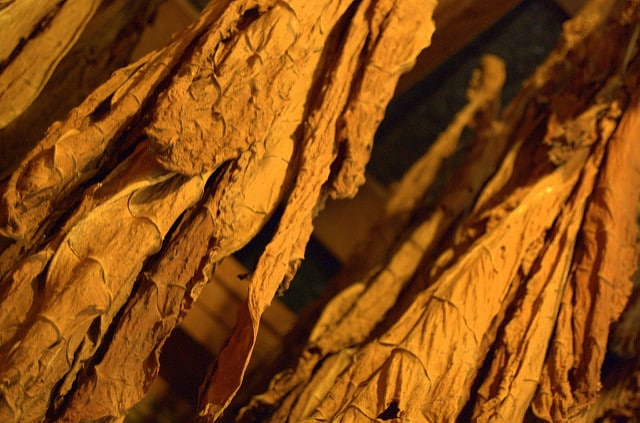
Rapé is traditionally prepared with dried and ground tobacco leaves. Image Source: Flickr CC user Steve Snodgrass
When blowing a pea-sized pellet of tobacco up someone’s nose, the key is to be measured and powerful with your breath. Shamans say the breath—and the intention behind it—is the crux to the proper administration of the Amazonian snuff called rapé in a ceremony which is traditionally an intense experience.
The ceremony actually involves two breaths, each of which shoots tobacco-based snuff deep into the two nasal cavities. Each breath is symbolic—the first breath through the left nostril symbolizes death, and the second breath through the right nostril represents rebirth. For the person receiving the rapé, each of these breaths is followed by an immediate sharp blow to the sinuses and head that clears the nasal cavity, purges the bowels, and ultimately leaves the person feeling calmer, grounded, and revitalized.
Practitioners who use this sacred plant medicine report that rapé is a powerful way to cleanse yourself of negative energy, ease pain, and stimulate detoxification. Research shows that rapé’s nicotine content gives it its stimulating and focusing effects and increases key hormones in the body like epinephrine and dopamine. While studies have yet to fully research its medicinal properties, some advocates purport that rapé decalcifies the pineal gland and encourages the production of DMT.
A lack of clinical studies hasn’t stopped this herbal snuff from growing in popularity among people looking for alternative ways to manage pain. But it’s important to understand the ritual and cultural heritage of rapé before endeavoring any practice at home. From the blend of snuff you choose to the pipe used to administer it, there are several tools every practitioner needs. But ultimately, as with any spiritual practice, the key to a truly beneficial rapé ceremony lies in your intention.
Choosing a Rapé Blend
The tobacco that’s traditionally used in rapé blends is a South American variety called Nicotiana rustica that’s up to 20 times stronger than the species of tobacco found in American cigarettes, Nicotiana tabacum. The tobacco is traditionally mixed with the ashes of other herbs and plants, which often hold cultural importance to the indigenous tribes that prepare the sacred snuff. One variety comes from the Jurua River valley in the Brazilian Amazon, and is prepared by members of the Kuntanawa tribe. It includes the local herbs lourinho—for spiritual cleansing—and kapaxanba—used to treat headaches. Another rapé from the Kaxinawa tribe contains the ash of the cumaru tree, a grounding substance which facilitates detoxification.
Purging, vomiting, or diarrhea is common after the ceremonial blowing of rapé. While uncomfortable, this helps your body purge itself of unnecessary toxins, and many practitioners see it as an important part of the cleansing process. But you can also choose a rapé blend that’s less likely to cause purging. While the principal ingredient in most rapé blends is tobacco, there are a few varieties that are tobacco-free. These are gentler and better suited for beginners, people with a general distaste for tobacco, and former smokers—in general, tobacco-free varieties will be less intense than those with N. Rustica, and they won’t make you purge.
Snuff Pipes and Sopladas
Beyond choosing a rapé blend, there’s also a pipe to consider, as well as the proper handling of the pipe. Rapé is administered by blowing small amounts of the snuff through a nose pipe made of bone, bamboo, or ceramic—one blow high into each nostril. The pipes used to administer rapé, which are often colorfully painted or decorated with feathers, are designed for either one or two people. For people who prefer to do a rapé ceremony in solitude, there’s a V-shaped pipe called a kuripe that you can use to self-administer a snuff, but it’s probably best to endeavor this only after you’ve experienced at least one two-person ceremony. Having the experience will leave you with a tangible idea of the breathing techniques used to carry out intentions.
The more traditional two-person pipe, called a tepi, is probably best for beginners, as the person blowing can control the breath and guide the ceremony. Whether you enlist the help of a professional practitioner or a trusted friend, the role of the person blowing is not one to be taken lightly. A rapé ceremony involves an intimate connection via the breath between the giver and receiver of the snuff; the person blowing holds intention for the person receiving the rapé and sends healing energy to help them realize that intention. Some say the energy exchange between two people is necessary for the ritual to be truly beneficial.
A blow, called a soplada, should be a deep, powerful breath from the stomach. It’s best to increase the intensity of the breath toward the end, pushing the rapé further up the nasal cavity and cleansing deeper. As the receiver, you’ll immediately feel a blow to your sinuses and head, as though they were being cleared out. And as this happens, you can expect mucus and snot drainage through the nose and the throat—this is healthy and encouraged.
Intention Is Key
Rapé is a powerful medicine that can help you let go of bad energies and past traumas and, more generally, it helps you hit a spiritual “reset button” in your life that physically and emotionally detoxes you. But, ultimately, medicines like rapé are tools to help carry out an intention—they are a means to an end, not an end themselves. Snuff blends and pipes are the tangible materials needed for a successful rapé ceremony, but the most important tool, though less concrete, is your intention.
A rapé ceremony offers you a unique opportunity to reconnect with your higher self and tap into an inner well of energy, peace, and willpower. If you want to use rapé to its full medicinal potential, you have to carry that momentum beyond the moment to integrate your intention into action. Whether it’s physical, emotional, or mental healing you’re looking for, your intention is further strengthened by the energy of the divine connection you share with a second person blowing the rapé, if you choose to enlist help. No matter if you choose to do it alone or with help, a rapé ceremony should be treated with respect. It’s only by giving the sacred medicine the reverence and attention it deserves that you can gain the most value and insight from the experience.










Very informative, thank you
Si te curas tu, me curo yo